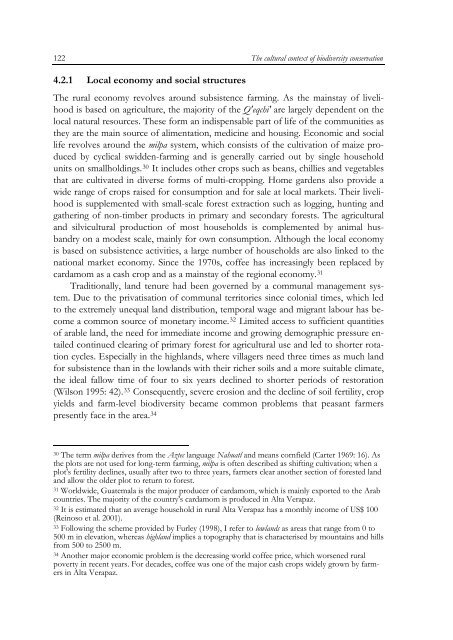The cultural context of biodiversity conservation - Oapen
The cultural context of biodiversity conservation - Oapen
The cultural context of biodiversity conservation - Oapen
You also want an ePaper? Increase the reach of your titles
YUMPU automatically turns print PDFs into web optimized ePapers that Google loves.
122<br />
4.2.1 Local economy and social structures<br />
<strong>The</strong> <strong>cultural</strong> <strong>context</strong> <strong>of</strong> <strong>biodiversity</strong> <strong>conservation</strong><br />
<strong>The</strong> rural economy revolves around subsistence farming. As the mainstay <strong>of</strong> livelihood<br />
is based on agriculture, the majority <strong>of</strong> the Q'eqchi' are largely dependent on the<br />
local natural resources. <strong>The</strong>se form an indispensable part <strong>of</strong> life <strong>of</strong> the communities as<br />
they are the main source <strong>of</strong> alimentation, medicine and housing. Economic and social<br />
life revolves around the milpa system, which consists <strong>of</strong> the cultivation <strong>of</strong> maize produced<br />
by cyclical swidden-farming and is generally carried out by single household<br />
units on smallholdings. 30 It includes other crops such as beans, chillies and vegetables<br />
that are cultivated in diverse forms <strong>of</strong> multi-cropping. Home gardens also provide a<br />
wide range <strong>of</strong> crops raised for consumption and for sale at local markets. <strong>The</strong>ir livelihood<br />
is supplemented with small-scale forest extraction such as logging, hunting and<br />
gathering <strong>of</strong> non-timber products in primary and secondary forests. <strong>The</strong> agri<strong>cultural</strong><br />
and silvi<strong>cultural</strong> production <strong>of</strong> most households is complemented by animal husbandry<br />
on a modest scale, mainly for own consumption. Although the local economy<br />
is based on subsistence activities, a large number <strong>of</strong> households are also linked to the<br />
national market economy. Since the 1970s, c<strong>of</strong>fee has increasingly been replaced by<br />
cardamom as a cash crop and as a mainstay <strong>of</strong> the regional economy. 31<br />
Traditionally, land tenure had been governed by a communal management system.<br />
Due to the privatisation <strong>of</strong> communal territories since colonial times, which led<br />
to the extremely unequal land distribution, temporal wage and migrant labour has become<br />
a common source <strong>of</strong> monetary income. 32 Limited access to sufficient quantities<br />
<strong>of</strong> arable land, the need for immediate income and growing demographic pressure entailed<br />
continued clearing <strong>of</strong> primary forest for agri<strong>cultural</strong> use and led to shorter rotation<br />
cycles. Especially in the highlands, where villagers need three times as much land<br />
for subsistence than in the lowlands with their richer soils and a more suitable climate,<br />
the ideal fallow time <strong>of</strong> four to six years declined to shorter periods <strong>of</strong> restoration<br />
(Wilson 1995: 42). 33 Consequently, severe erosion and the decline <strong>of</strong> soil fertility, crop<br />
yields and farm-level <strong>biodiversity</strong> became common problems that peasant farmers<br />
presently face in the area. 34<br />
30 <strong>The</strong> term milpa derives from the Aztec language Nahuatl and means cornfield (Carter 1969: 16). As<br />
the plots are not used for long-term farming, milpa is <strong>of</strong>ten described as shifting cultivation; when a<br />
plot's fertility declines, usually after two to three years, farmers clear another section <strong>of</strong> forested land<br />
and allow the older plot to return to forest.<br />
31 Worldwide, Guatemala is the major producer <strong>of</strong> cardamom, which is mainly exported to the Arab<br />
countries. <strong>The</strong> majority <strong>of</strong> the country's cardamom is produced in Alta Verapaz.<br />
32 It is estimated that an average household in rural Alta Verapaz has a monthly income <strong>of</strong> US$ 100<br />
(Reinoso et al. 2001).<br />
33 Following the scheme provided by Furley (1998), I refer to lowlands as areas that range from 0 to<br />
500 m in elevation, whereas highland implies a topography that is characterised by mountains and hills<br />
from 500 to 2500 m.<br />
34 Another major economic problem is the decreasing world c<strong>of</strong>fee price, which worsened rural<br />
poverty in recent years. For decades, c<strong>of</strong>fee was one <strong>of</strong> the major cash crops widely grown by farmers<br />
in Alta Verapaz.

















